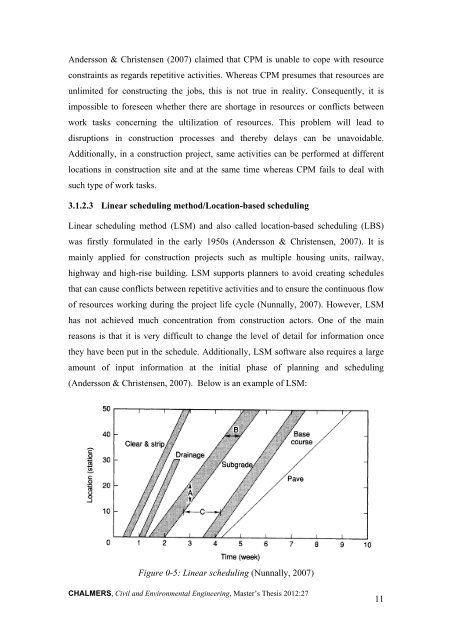impact of 4d modeling on construction planning process - Chalmers ...
impact of 4d modeling on construction planning process - Chalmers ...
impact of 4d modeling on construction planning process - Chalmers ...
You also want an ePaper? Increase the reach of your titles
YUMPU automatically turns print PDFs into web optimized ePapers that Google loves.
Anderss<strong>on</strong> & Christensen (2007) claimed that CPM is unable to cope with resource<br />
c<strong>on</strong>straints as regards repetitive activities. Whereas CPM presumes that resources are<br />
unlimited for c<strong>on</strong>structing the jobs, this is not true in reality. C<strong>on</strong>sequently, it is<br />
impossible to foreseen whether there are shortage in resources or c<strong>on</strong>flicts between<br />
work tasks c<strong>on</strong>cerning the ultilizati<strong>on</strong> <str<strong>on</strong>g>of</str<strong>on</strong>g> resources. This problem will lead to<br />
disrupti<strong>on</strong>s in c<strong>on</strong>structi<strong>on</strong> <strong>process</strong>es and thereby delays can be unavoidable.<br />
Additi<strong>on</strong>ally, in a c<strong>on</strong>structi<strong>on</strong> project, same activities can be performed at different<br />
locati<strong>on</strong>s in c<strong>on</strong>structi<strong>on</strong> site and at the same time whereas CPM fails to deal with<br />
such type <str<strong>on</strong>g>of</str<strong>on</strong>g> work tasks.<br />
3.1.2.3 Linear scheduling method/Locati<strong>on</strong>-based scheduling<br />
Linear scheduling method (LSM) and also called locati<strong>on</strong>-based scheduling (LBS)<br />
was firstly formulated in the early 1950s (Anderss<strong>on</strong> & Christensen, 2007). It is<br />
mainly applied for c<strong>on</strong>structi<strong>on</strong> projects such as multiple housing units, railway,<br />
highway and high-rise building. LSM supports planners to avoid creating schedules<br />
that can cause c<strong>on</strong>flicts between repetitive activities and to ensure the c<strong>on</strong>tinuous flow<br />
<str<strong>on</strong>g>of</str<strong>on</strong>g> resources working during the project life cycle (Nunnally, 2007). However, LSM<br />
has not achieved much c<strong>on</strong>centrati<strong>on</strong> from c<strong>on</strong>structi<strong>on</strong> actors. One <str<strong>on</strong>g>of</str<strong>on</strong>g> the main<br />
reas<strong>on</strong>s is that it is very difficult to change the level <str<strong>on</strong>g>of</str<strong>on</strong>g> detail for informati<strong>on</strong> <strong>on</strong>ce<br />
they have been put in the schedule. Additi<strong>on</strong>ally, LSM s<str<strong>on</strong>g>of</str<strong>on</strong>g>tware also requires a large<br />
amount <str<strong>on</strong>g>of</str<strong>on</strong>g> input informati<strong>on</strong> at the initial phase <str<strong>on</strong>g>of</str<strong>on</strong>g> <strong>planning</strong> and scheduling<br />
(Anderss<strong>on</strong> & Christensen, 2007). Below is an example <str<strong>on</strong>g>of</str<strong>on</strong>g> LSM:<br />
Figure 0-5: Linear scheduling (Nunnally, 2007)<br />
CHALMERS, Civil and Envir<strong>on</strong>mental Engineering, Master’s Thesis 2012:27<br />
11















